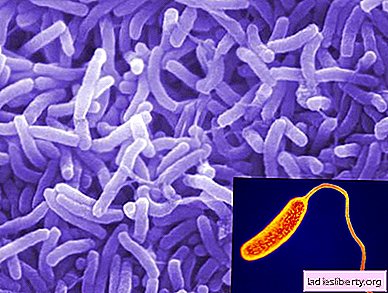
Cholera is an acute infectious disease characterized by damage to the small intestine, a disorder of water-salt metabolism, varying degrees of dehydration due to fluid loss, with vomit and watery bowel movements. Cholera refers to quarantine infections. The causative agent of the disease is cholera vibrio, resembling a curved stick (comma) in appearance.
When boiling, the vibrio dies after one minute. Some biotypes can persist and reproduce for a long time in silt, iodine, in the organisms of the inhabitants of reservoirs. The source of infection is a person (a carrier and a patient). Vibrios are excreted with vomit and feces. Epidemics of cholera are contact-household, food, water and mixed. The susceptibility to the disease is quite high.
Cholera - reasons
The disease is caused by cholera vibrio. Routes of transmission from a sick person - usually through water contaminated with vomit and feces, usually when swimming in a pond or swallowing water. Cholera infection can occur by eating various foods that have been washed with contaminated water. Nowadays, cholera is quite rare, usually in the form of epidemics in areas that are characterized by unfavorable sanitary conditions (Africa, Asia).
Cholera - Symptoms
The incubation period of cholera is about 5 days. The disease begins suddenly. The cholera vibrio toxin provokes severe diarrhea, in which a huge amount of fluid is released along with feces. Mucus, impurities of blood and pain are not observed. The stool is first mushy, then colorless, later abundant vomiting is added to the symptoms.
Acute dehydration of the whole organism occurs, metabolic processes are disturbed, a decrease in potassium level occurs, as a result of which the heart rhythm changes. The skin loses its elasticity, the patient is inhibited, facial features are sharpened, convulsions of the masticatory and calf muscles appear. Dehydration can result in death from renal failure, hypovolemic shock, coma.
Cholera - diagnosis
When making a diagnosis, great importance is given to epidemiological data that allow us to establish the likelihood of contact with the causative agent of cholera, as well as clinical data (symptoms of cholera). However, the greatest importance is given to laboratory diagnostic data, allowing to confirm the diagnosis.
Diagnostic methods for cholera are divided into classical (bacteriological research and bacterioscopy) and rapid methods (microagglutination and immobilization of vibrios). Cholera needs to be differentiated with other intestinal infections, such as salmonellosis and dysentery, as well as poisoning with heavy metal salts and mushrooms.
Cholera - treatment and prevention
Mandatory hospitalization of all patients. The main role in the treatment of cholera is given to the restoration of water-salt balance and the fight against dehydration. Solutions that contain potassium chloride, glucose, sodium chloride and sodium bicarbonate are recommended. In case of especially severe dehydration, patients are shown jet injection of fluid to normalize the pulse, after which the solution is administered dropwise.
The patient's diet should consist of foods rich in potassium salts (tomatoes, dried apricots, potatoes). Antibiotic therapy is carried out only for patients with a high degree of dehydration, chloramphenicol or tetracycline are used. An extract from the hospital is carried out after full recovery. The prognosis for adequate and timely treatment is favorable.
Prevention of cholera consists in the disinfection and protection of drinking water. Active medical monitoring of persons who were in contact with patients is required. For the purpose of prevention, according to indications, cholerogen-toxoid and corpuscular cholera vaccine are used.











